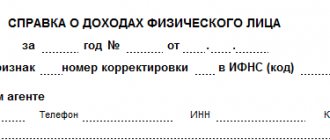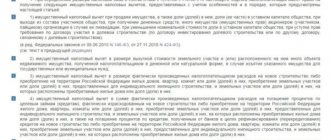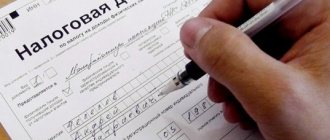The year in which the tax deduction began to be used is the 365 days for which the individual applying for a reduction in the tax base declared income tax compensation for the first time in the declaration. Why this term was invented, how to correctly determine this year, as well as where to indicate it in the 3-NDFL form and how to fill out some other fields on the same page will be explained in the article.
- Download the blank 3-NDFL form for free here.
- See an example of a declaration here.
- Use the program for 3-NDFL by going here.
Year of start of using the deduction
In addition, persons who do not make any expenses at all, but simply have the right to do so by law, can also reduce the size of the tax base. We are talking about parents of minor children applying for a standard tax discount, as well as beneficiaries.
It should be noted that before you begin to determine the year that will serve as the beginning of the use of the deduction, make sure that the statute of limitations for receiving it has not expired. If we are talking about personal income tax compensation for social types of expenses, then compensation of this kind is accrued only in the first three years that have passed from the moment the money was spent.
As for the year in which the tax deduction began to be applied, this is a certain time period of 365 days during which the taxpayer, as a result of the accrual of a certain type of tax discount, was first compensated for the overpaid personal income tax.
Why was this term introduced?
Many individuals do not know what the initial year of application of the tax deduction is, or do not at all understand why this term was introduced by the Federal Tax Service. The need to identify such a year is closely related to the income tax refund procedure, which is implemented according to the following rules:
- It is determined how much the taxpayer paid in personal income tax during the year. On the territory of the Russian Federation, there is a rule according to which, regardless of what amount of deduction is accrued to an individual, he still cannot be compensated for more in a year than he paid for personal income tax during the same period of time.
- The amount of compensation is divided by the annual amount of tax paid. Next, the total amount of compensation is taken and divided by the amount that the recipient of the deduction contributed to tax contributions over the last year (it is assumed that the last few years personal income tax was paid in the same amount). For example, the amount of the social tax discount is 14,800 rubles, and the amount of personal income tax paid is 5,850 rubles. Thus, by paying back 5,850 rubles each year, the taxpayer is fully compensated for social expenses for three years (14,800/5,850 = 2.5).
In this regard, in order for the tax inspector to understand how much and what part of the tax rebate he must reimburse an individual in accordance with this 3-NDFL form, it is necessary to correctly establish and indicate the year that served as the beginning of the use of the deduction. If the amount of the tax discount is small and it is transferred to the taxpayer in a one-time payment, then entering this indicator is not required.
Filling out 3-NDFL
But before that, let’s remember what the 3-NDFL document and the tax deduction itself are.
A declaration in form 3-NDFL, as one of the types of documentary report, contains information about the financial movements of the taxpayer during one year.
The report is not allowed in free form, but has a strictly defined form by order. 3-NDFL includes the following main features, features and characteristics.
- The front sheet contains digital encoding about the tax authority where the document is submitted, the tax period marked, plus information about the taxpayer according to the passport.
- The section on tax calculations following the front sheet indicates the status of the tax: payable to the budget, subject to return to the taxpayer, or the absence of both. The section also contains KBK and OKTMO numbers.
- The general calculation of the tax base, as the actual amount of the taxpayer’s financial income and the tax paid on it, is another section of the declaration in form 3-NDFL.
- Sources of income are an integral part of the report. This is subject to mandatory indication with the amounts and types of income (salary, bonus, profit from individual activities, etc.). For each type of income there is a corresponding form to fill out, which is called in capital letters of the Russian alphabet A, B, C, or G.
- A type of tax deduction, also subject to a detailed description on forms specially created for this purpose. These are sheets D1, D2, E1, E2, F, Z, I.
The 3-NDFL declaration, as already mentioned, may contain distinctive features, depending on the purpose of filing the declaration with the Federal Tax Service and the subject that caused this need. More specifically it could be:
- Declaration of amounts of financial income and taxes withheld from them. Declaration 3-NDFL may have characteristic features depending on the subject of the declaration: rental of housing, sale of property, individual entrepreneurship, etc.;
- refund of overpaid tax, in other words, tax deduction. It is also divided into several types: standard, social, property.
Thus, we come closer to an integral part of the topic of the article - tax deductions. This is income tax paid by the taxpayer in the time and manner prescribed by law. Upon expiration and closing of the financial year, a person who has paid all taxes in good faith has the right to return all or part of this amount.
This right arises when a citizen performs certain actions. These actions include:
An important point in a citizen’s presentation of his right to the Federal Tax Service for the return of a tax deduction by filing a 3-NFDL declaration is: the closure of the past financial year. That is, if you have not yet paid all due taxes for the current year, then you cannot claim their refund.
In short, it means the first annual period in which a tax deduction from the budget was returned to the taxpayer.
In more detail, we should start from the tax deduction return rule. Buying or building a home is always an expensive expense. And often the amount to be refunded is several times greater than the tax actually paid by the citizen for the past year.
The tax inspector does not have the right to confirm a desk audit of the 3-NDFL declaration, where the refund amount required by the taxpayer is greater than what he paid to the state as tax. Therefore, a citizen claiming this right should divide the refund amount over several years.
Clause 1.11, indicating the year in which the deduction began to be used, must be completed in the declaration in Form 3-NDFL in the specially designated sheet D1.
How to determine the starting year of the tax discount
In order to correctly identify the time period that is the first year of using tax compensation, it should be borne in mind that this is not the 365 days during which the taxpayer first received the material funds under the issued deduction. This is the year for which they were listed. In addition, it is worth remembering that you can claim a personal income tax refund for a particular tax period only when it is completely over (that is, starting from the beginning of the next year).
For example, an individual decided to use the service of reducing the size of his tax base and return the personal income tax overpaid in 2015. Accordingly, the taxpayer must complete and submit the declaration form in Form 3-NDFL for consideration no earlier than 2021.
In this case, despite the fact that when the recipient of the tax deduction first receives cash compensation (in 2021, 2021...), the year of commencement of the use of the tax rebate will be considered exactly those 365 days for which the individual was first reimbursed for the tax. In the example under consideration, this is 2015.
Instructions for registration
The question of how to get a standard deduction does not lose its relevance. Registration of standard deductions for children or for the employee himself can be done through the employer or through the Federal Tax Service. When filing a tax refund from an employer, you will need to complete the following steps:
- Write an application for an income tax refund.
- Prepare documents confirming the legality of its receipt.
If the refund is issued through the Federal Tax Service, then you can apply for it only at the end of the calendar year for which the taxpayer wants to receive a personal income tax refund. The following documents will be required:
- Certificate of income.
- 3NDFL reporting.
- Documents evidencing the right to reduce the tax base for calculating income tax.
- Application for a deduction.
Documents that confirm the applicant's right to receive this standard type of compensation include:
- Birth or adoption certificate (if the taxpayer is an adoptive parent).
- Marriage certificate.
- Certificate of disability (if there are disabled children).
- Certificate from the place of study (if the age of children who are full-time students is over 18 years old).
- In case of payment of alimony, a writ of execution for the transfer of alimony will be required.
- If the application is submitted by one of the parents who is not officially married, providing for children without paying child support, then a receipt from the second parent will be required stating that the person applying for the deduction is involved in providing for the children.
In order to accurately calculate the amount of compensation due, it is necessary to list the children in the order of their birth. The first-born is the eldest in age, regardless of whether a tax refund is granted to him or not.
Where in the declaration is this parameter indicated?
As you know, in order for an individual to be granted a tax deduction, it is necessary to fill out the 3-NDFL form, and do it correctly and enter all the necessary indicators. The year that became the beginning of the use of tax compensation must be indicated when registering such deductions, which are characterized by a considerable amount. As a rule, these are property tax discounts, for which page D1 is allocated in form 3-NDFL.
Filling out page D1
Declaration sheet D1 is devoted to the calculation of property compensation for expenses for the purchase and construction of real estate. The year of application of the property-type deduction is recorded in the first paragraph of this page (subparagraph 1.11), in line 110. To indicate this indicator, four empty cells are allocated, in each of which the individual must enter a number. For example, if it is 2021, then a two is entered in the first cell, a zero in the second, a one in the third, and a seven in the fourth.
Attention! If an applicant for a reduction in the tax base is filling out form 3-NDFL by hand, then he should take into account that this can only be done with a blue or black pen, each number must be strictly inside the cell designated for its indication and must be written very clearly and carefully.
Since income tax refunds are only possible if absolutely all sheets of the form are filled out correctly, we advise you to pay attention to how some other fields on page D1 are formatted:
- Line 010. Here you need to enter only one number, which makes it clear to the tax agent what kind of real estate we are talking about. If an individual has invested material resources in the purchase or construction of an apartment, then you need to write two, if at home - one, if you purchased a plot of land with property already on it - six.
- Line 020. Since there is more than one form of ownership that can be registered for housing, it must be indicated in the declaration. This is done by entering the number 1, 2, 3 or 4 in the line with code 020. If the property is owned exclusively by the taxpayer, then a unit is registered, but if the housing is registered as common property - a two or three (for shared ownership - number 2, and for joint - the number 3), and if the owner of the property is a minor individual, then a four is written.
- Line 030. Since the overpaid tax can be reimbursed not only to the owner of the property, but also to his close relatives, on page D1 it is necessary to note who exactly is applying for this compensation. If this is the owner himself, then code 01 is used, if his wife or husband - 02, and if his mother or father (when it comes to property deductions for an object owned by a minor owner) - 03.
If individuals live in a civil marriage and are not officially husband and wife, then it is pointless to claim a property deduction for a spouse, since for its accrual a mandatory condition is to provide a marriage certificate to the tax office.
Sometimes individuals register real estate as shared ownership either between themselves and a child who has not reached the age of majority, or between themselves, a child and a wife/husband. In the first case, in the line with code 020 you need to write the numeric code 13, and in the second - 23.
Start year of using the tax deduction
1. I’m filling out 3 personal income taxes, but I can’t figure out the column for the year the tax deduction began to be used? From the years 12,13,15, we didn’t use the deduction, but decided to use it now, so in this column for the years 12,13,15, which years should we put?
1.1. Hello. The year the deduction began to be used was 2012.
2. Which year should be considered the year when the tax deduction began to be used when purchasing an apartment under an equity participation agreement to fill out Form 3 of the personal income tax - the year of signing the act of acceptance of the apartment (in my case, this is December 2014) and the year of taking ownership (certificate of ownership dated June 2015 G.). Thank you.
2.1. the date that appears on the certificate of ownership
3. Form 3 Personal Income Tax Sheet And subclause 1.10 - the year of the beginning of the use of the property tax deduction, in which the tax base was reduced for the first time. If I bought an apartment in 2013, and receive deductions from 2010 to 2012 (since I am a pensioner), then what is the year when I started using the deduction - 2013 or 2010? The 2010 Declaration program does not allow you to set the deduction start year to be less than the year of purchase (although this can be done for 2011 and 2012)
What to put on the 3-NDFL form
In accordance with the regulations of the Tax Code of the Russian Federation, the right to use compensation appears at the time of receipt of the certificate of acquisition of the property. This is the year that needs to be recorded on the form.
The deadline for receiving the document does not play a determining role. In practice, not in all cases the date of drawing up the extract can be recognized as the year from which the citizen began to receive an income tax refund.
Dear readers! The article talks about typical ways to resolve legal issues, but each case is individual. If you want to find out how to solve your particular problem, contact a consultant:
+7 (St. Petersburg)
APPLICATIONS AND CALLS ARE ACCEPTED 24/7 and 7 days a week.
It's fast and FREE!
Property tax deduction: General information. Personal experience
In the comments to the post (https://pikabu.ru/story/novostroyka_v_ipoteku_lichnyiy_opyit.) people were thirsty for details on how to lighten the burden called a mortgage at least a little. And if you buy an apartment without a mortgage, saving is always nice.
Here we will be helped by the property deduction provided to citizens on the basis of Art. 220 of the Tax Code of the Russian Federation. I’ll make a reservation that everything is considered in the most general way for standard cases, there are a lot of individual situations, I’ll point out some, but it’s impossible to cover everything. Another clarification - this applies to real estate purchased after January 1, 2014. The filling out of the declaration itself is described for the case of using a special program.
All information is based on personal experience (no one has ever returned dissatisfied, hehe).
So, let's go in order by situations and documents:
1. You buy an apartment/house/share. If this is an agreement of shared participation (DPA) in construction, for the purposes of a tax deduction, the act of acceptance and transfer of the object to you is sufficient, but if it is a secondary project, the corresponding extract from Rosreestr, which is now issued instead of a certificate of registration of ownership. In total, you have a contract and an act/extract in your hands.
1.1. If you decide to take out a mortgage, you additionally have an agreement with the Bank.
2. Now about the money spent. To receive a deduction, you must confirm your expenses for the purchase/construction of housing. So that the tax office can see that the money has been transferred from you to the developer/bank/buyer. For example, for DDU you must have receipts, for purchase and sale with an individual - a receipt.
3. Deadlines. The date of occurrence of the right to deduction is the date of the act (in the case of DDU) or the date of registration of the transfer of ownership. The year is key because you can only begin filing for the deduction in the year following the date the deduction became eligible. So, if you bought it in 2015 and received the necessary documents, you submit the first declaration only in 2021 for 2015. You can receive it until you select the entire balance, I’ll tell you about it later, and everything will become clear.
4. 2-NDFL. To receive a deduction, you need to order such a certificate from your employer about the taxes withheld from you. For the period for which you want to receive a deduction. So, if you submit a declaration for 2015, you need to attach 2-NDFL about what you earned in 2015.
Unfortunately I can't attach pictures. I'll describe it this way.
6.1. In the “Setting conditions” section, select the inspection number by searching for your inspection on the website of the same tax office (https://service.nalog.ru/addrno.do), select the registration address - you are told the number and code of the tax authority. The taxpayer indicator for our standard situation is Another individual. Leave all the default checkmarks and dots.
6.2. The next section is “Information about the declarant”. Fill in all fields in two tabs. You can find the current octmo and address through the search system by entering your address.
6.3. Income section. We fill in the information from 2-NDFL. The source of payments is our employer, we rewrite all the information about him (name, tax identification number, octmo, and so on). Next, in accordance with the same 2-personal income tax, we carefully enter the income for each month in exact accordance. Pay attention to income codes!! Below we copy the rest of the information from the certificate.
6.4. Section "Deductions". We remove the checkmarks from all the tabs about standard deductions and social, we need a third one. We indicate information about the object, that is, about the purchased property. How you bought it (DDU or purchase and sale), what you bought (apartment/house/share, etc.), who bought it (look at the extract - are you listed as the sole owner, or is it a common shared property), where did you buy it (full address of the property) , the date of the relevant document (act, certificates, extract), the year the deduction began to be used (for which year did you first file the declaration /not in which year, but FOR which one/; I hope the difference is clear from the previous ton of text), the cost of the object/share ( see below for details), interest on loans (the same).
The total cost is duplicated from the cost of the object/share indicated above; the deduction for previous years is filled out if you have previously filed a declaration. To this question, as well as what is the amount carried over from the previous year; If anyone needs it, I’ll answer in the comments.
7. The declaration is submitted throughout the year following the year for which you submit it.
9. Deduction by %. This point logically follows from the previous one. It makes sense to claim a deduction for interest when you used a property deduction for the housing itself. With percentages, in principle, everything is simpler. Get a certificate from the bank stating how much interest you paid on your mortgage loan each year. This amount is indicated in the “Deductions” section, where information about the property being purchased is located. The topic of interest has not been covered; this is still a large layer of information.
10. Submitting and receiving money. When you go to the tax office, attach to your declaration a copy of your passport, the original 2 personal income taxes, copies of contracts, payment documents, certificates, acts and extracts (everything was indicated in the post). There you write an application, forms are available at the tax office, where you indicate that you want to receive a property deduction for such and such a year in such and such an amount (look at the numbers in the printed declaration), indicate bank information to receive money. In accordance with the law, the audit takes 3 months, the tax office has a month to deliver the money to the account. In fact, it's often faster.
11. Nuances and common situations.
11.1. The cost of the object (mentioned in clause 6.4). When you buy individually, not married, the cost of the object specified in the contract is indicated. If you bought an apartment while married and registered it in full in the name of one of the spouses, and according to the rules of the Family Code, the property acquired through compensated transactions is common property, you can write an application to the tax office and ask to distribute the deduction between the spouses in any shares. For example, an apartment costs 3 million, is registered in the name of the husband, but the wife earns significantly more, the spouses want to distribute 2 million to the wife, 1 million to the husband, for this an application is submitted with approximately the following content: “To such and such tax office, from such and such citizens Application . Based on paragraphs. 2 p. 1 art. 220 we distribute the property tax deduction for personal income tax on expenses for the purchase of an apartment on the territory of the Russian Federation (full details: address, area, cadastral number) as follows: husband’s full name - in the amount of 1 million, wife’s full name - in the amount of 2 million ..
11.2. If a pensioner buys. The deduction can be carried forward to three previous years. If a pensioner bought an apartment in 2021 and retired in 2021, but cannot choose a full deduction for income for 2021, and we remember, and we remember that a deduction is, roughly speaking, a refund of the tax paid, he can do this as follows: submit a declaration for the 3 years preceding the year of purchase of the apartment, that is, for 2021, 2015 and 2014.
I wanted it to be brief, but it turned out to be a long post, and there’s still a lot of information.
Sorry for the chaotic presentation, I’m not much of a writer, to put it mildly, the main thing was to convey the information. I hope the goal is achieved.
How to submit
Procedure:
- Collection of the main package of documentation.
- Filling out a standard declaration.
- Submission of papers for consideration to the territorial division of the tax office (at the applicant’s place of permanent residence).
- Waiting for the completion of the desk audit.
- Receiving funds.
Methods for filing a declaration:
| Independent interaction with authorized agents of the tax authority | At your place of permanent residence. |
| By mail | Dispatch occurs via registered mail at the place of registration (receipt receipt is required). |
| Through a specialized service | In your personal account on the official portal of the federal inspection. |
When sending a registered letter, the date of submission is taken to be the day recorded on the postmark.
Package of papers in 2021:
- official certificate of ownership;
Sample certificate of state registration of rights
Real estate transfer and acceptance certificate
Sample certificate 2-NDFL
Sample application for tax refund
Bank account details
How to indicate which year
The year in which the deduction began to be used is the calendar year for which the declaration was filed for the first time, and not in which year it was filed.
That is, if the apartment was purchased in 2021, then the declaration should be submitted in 2021, it is allowed to do this in 2021 and 2021. But the year of start of use will be considered 2021. Not the year when the applicant received his money, and not the one when he filed a declaration.
Starting year – the year for which the deduction was issued. It is very important to correctly fill out the 3-NDFL form in order to correctly reflect the facts and thereby not create preconditions for being denied the right to deduction.
When receiving a deduction for the purchase of an apartment, you can look at the extract from the Unified State Register to see when ownership was registered. This will be the beginning of using the deduction.
Features for a pensioner
All tax payers, including persons of retirement age, are subject to a single condition, according to which the right to make a deduction arises from the year of receipt of the official certificate of ownership or transfer deed (after purchase under an agreement on shared participation in construction work).
There are two possible situations. Under the first, the refund is carried out for an employed pensioner, and under the second, for persons who do not have a job and receive social security on a monthly basis.
Role of the year for the tax service
Since the entire amount of the deduction due can be divided, and its receipt will extend over several years, it is important for the Federal Tax Service to identify the moment the taxpayer begins to use his right.
Tax legislation determines that whatever amount is accrued for refund, during a calendar year it should not exceed the amount of personal income tax paid for the same period.
Therefore, the tax office determines how much tax was paid in 365 days. And divides the deduction amount by this indicator, thereby calculating how many years the compensation will be fully paid.
But if the amount of the tax deduction is small and will be transferred at one time, then there is no need to indicate the beginning of its use.
Deduction for treatment and purchase of medicines
The deduction is provided in the amount paid by the taxpayer during the calendar year for medical services provided by medical organizations and individual entrepreneurs engaged in medical activities and having the appropriate licenses, as well as in the amount of the cost of drugs for medical use prescribed by the attending physician or purchased by an individual at his own expense.
You can use the deduction both for your own treatment and for the treatment of your spouse, parents, your own and adopted children under the age of 18, and children under guardianship under the age of 18. The type of treatment must be named in a special list (Resolution of the Government of the Russian Federation of March 19, 2001 No. 201).
The deduction amount cannot exceed 120 thousand rubles. Expenses for expensive medical treatment are also included in this category of deductions. The list of medical services and medications for expensive treatment is also approved by the Government of the Russian Federation. The list includes expensive medical services for surgical treatment, transplantation, therapeutic and complex treatment, nursing of premature babies, IVF, etc. There are no spending restrictions. The deduction is provided in the amount of actual expenses incurred for these medical services, but not more than the taxpayer’s taxable income for the calendar year. If a taxpayer wants to take advantage of a deduction for the treatment of close relatives, then all documents (agreement, payment receipts) must be issued for him, and not for relatives receiving paid medical care. The wording in the documents should be as follows: “The agreement was concluded with Ivanov for the provision of medical services.
The deduction can be used in any of the three ways described above. The list of documents required to confirm expenses for treatment is exactly the same as for education. When paying for expensive treatment, you must additionally provide a certificate from a medical organization or individual entrepreneur stating that the treatment falls under this category.
Social tax deductions, with the exception of deductions for expensive treatment and education of children, are provided in the amount of actual expenses incurred, but in total no more than 120 thousand rubles for the tax period. The fixed amount for the education of children, which can be used to receive a deduction, is 50 thousand rubles. Deductions for expensive treatment are applied in the amount of expenses actually incurred, within the taxable income of the taxpayer, there are no restrictions.
Column location
There are two ways to submit a return to receive the deduction:
- Online. On the Federal Tax Service website through the taxpayer’s Personal Account, it is possible to automatically generate a 3-NDFL declaration by filling out the required form. Or upload an electronic document.
- On paper. When entering information into a printed form, the applicant must be careful - use only a ballpoint or fountain pen, blue or black, do not go beyond the edges of the allocated cells, put a dash if the cell is empty, etc.
When filling out a paper form, the start of using the deduction is reflected in subclause 1.11 (line code 110) on sheet D1.
What are the deductions?
A deduction is an amount for certain expenses that reduces an individual's taxable income. Only individuals paying personal income tax can take advantage of the deduction.
The Tax Code of the Russian Federation provides for the following deductions: - standard tax deductions. As a rule, they are provided by the employer at the individual’s place of work. They have a fixed amount, which depends on the taxpayer category, the number of children and the amount of income;
— social tax deductions (expenses for training, treatment and purchase of medicines, expenses for the funded part of the pension and non-state pension provision, voluntary pension insurance, voluntary life insurance, as well as expenses for charity). These deductions in a fixed amount reduce the taxable income of an individual received during the calendar year. The deduction is provided both by the employer, upon written application of the individual, and by the Federal Tax Service - when the taxpayer fills out the 3-NDFL declaration. Deductions for charitable expenses are provided only by the inspectorate;
— investment tax deductions. The deduction is provided to individuals who carry out certain transactions with securities, deposit funds into an investment account, and receive income from transactions related to the investment account. The deduction is provided by the tax agent through whom all of the above operations and actions take place, or by the tax authority;
— property tax deductions. The right to these deductions for an individual arises when selling property and buying housing, constructing housing, purchasing a plot of land for building housing, or purchasing housing from the state. When purchasing housing, land, or building housing, you can take advantage of the deduction by submitting 3-NDFL to the Federal Tax Service or by providing a notification to the employer. When selling property, the deduction is provided only by the tax authority;
— professional tax deductions. The deduction is provided to individual entrepreneurs, notaries and individuals engaged in private practice, lawyers who have established a law office, individuals providing services and performing work under civil contracts, individuals receiving royalties, provided that these categories of taxpayers cannot document their expenses associated with generating income. A deduction is provided in the amount of 20 percent of the amount of income received. You can receive a deduction from the tax authority when filling out 3-NDFL or from your employer by submitting an application;
— tax deductions when carrying forward losses from transactions with securities and transactions with financial instruments of futures transactions. A deduction is provided if expenses from the above operations exceed income, that is, a loss is received. The resulting loss is taken into account for 10 years, starting from the year the loss was received. You can use the deduction only by submitting 3-NDFL to the inspectorate.
These are all types of deductions prescribed in the Tax Code of the Russian Federation. They can be used by individuals who are registered at their place of work in accordance with the labor code and receive an official salary, as well as individual entrepreneurs who apply the general taxation system and pay personal income tax. We will look in more detail at the tax deductions that are used most often. Such deductions include social and property.
How to fill out sheet D1
Page D1, like all sheets of the declaration, must be filled out carefully and correctly. Numbers and letters are written clearly and in a strictly designated field. In the line “year of start of using the deduction” there are four empty squares; in them you need to enter numbers, one in each cell, from left to right, starting with the leftmost one.
Blots, corrections, strikethroughs, etc. are not allowed; if they are present, the inspector will not accept the document from the applicant. It is also necessary to make sure that the applicant’s signature is on all sheets where this is required.
The beginning of the use of the deduction is the year for which the declaration is filed - a report to the state on the citizen’s personal income, and not the year in which he decided to exercise his right. Whatever filling method the applicant chooses, he must take this procedure seriously - after all, there are rules, the violation of which will create difficulties in obtaining a deduction.
The article was written based on materials from the sites: www.9111.ru, pikabu.ru, backnalog.ru.
«









